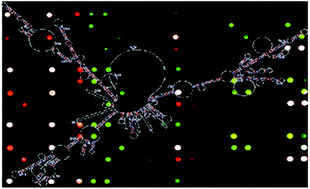The factors that affect the formation and stability of DNA/DNA duplexes are complicated and still mostly unknown. In this study attempts were made to look for the crucial factor affecting hybridization failure in DNA microarray assays. A comprehensive range of factors were investigated simultaneously using a 25-mer oligonucleotide Potyvirus microarray. These included steric hindrance, direct/indirect labelling types, distance of a probe to the fluorescent labelling end, target (the DNA fragment used to hybridize with microarray probes) strand types either single strand or double strand, probes without mismatch and with different numbers of mismatch nucleotides (up to 36%) and different mismatch locations (5′ end, centre and 3′ end), probe GC content and Tm, secondary structures of probes and targets, different target lengths (0.277 kb to ∼1.3 kb) and concentrations (0.1–30 nM). The results showed that whilst most of these known factors were unlikely to be the main causes of failed hybridization, there was strong evidence suggesting that the viral amplicon target structure is the most crucial factor. However, computing predicted target secondary structures by Mfold showed no correlation with the hybridization results. One explanation is that the predicted target secondary structures are different from the real structures. Here we postulate that the real target structure might be a combination of secondary structures resulting in a three-dimensional structure from exposure to three types of sub-structures: (1) a completely exposed linear structure to allow probes access for the successful hybridization and showing strong fluorescent signals; (2) a partially exposed structure to allow unstable binding and showing weak fluorescent signals; (3) a closed structure resulting in failed hybridization. These results are very important for microarray based studies as they not only provide an explanation for some current controversial results, but also provide potential resolution for the future studies. Due to the lack of available software for predicting the true target structure, development of microarrays should conduct an initial oligonucleotide probe selection procedure and those probes with capacity to hybridize with the target should be considered for the microarray development.

You have access to this article
 Please wait while we load your content...
Something went wrong. Try again?
Please wait while we load your content...
Something went wrong. Try again?


 Please wait while we load your content...
Please wait while we load your content...